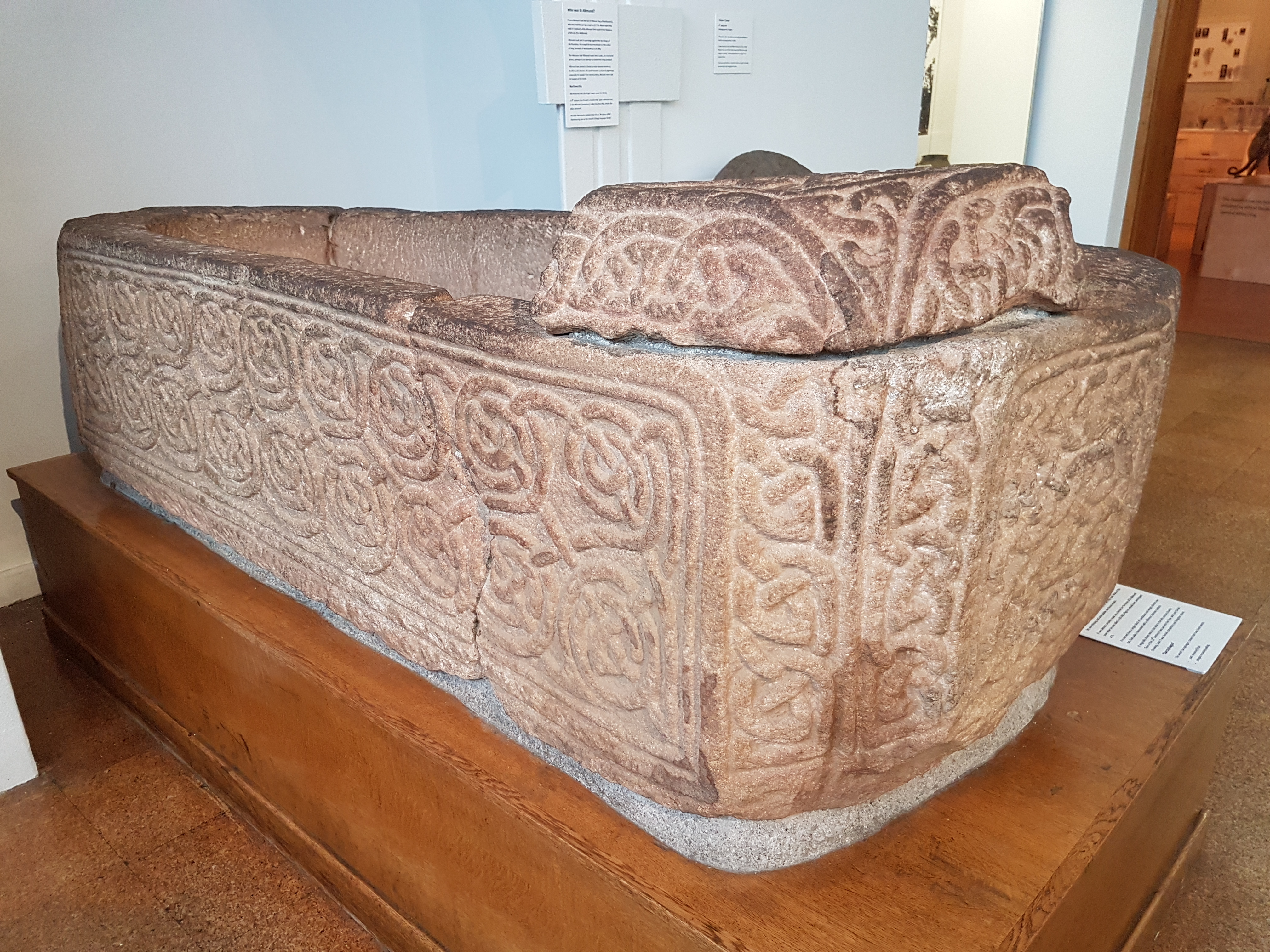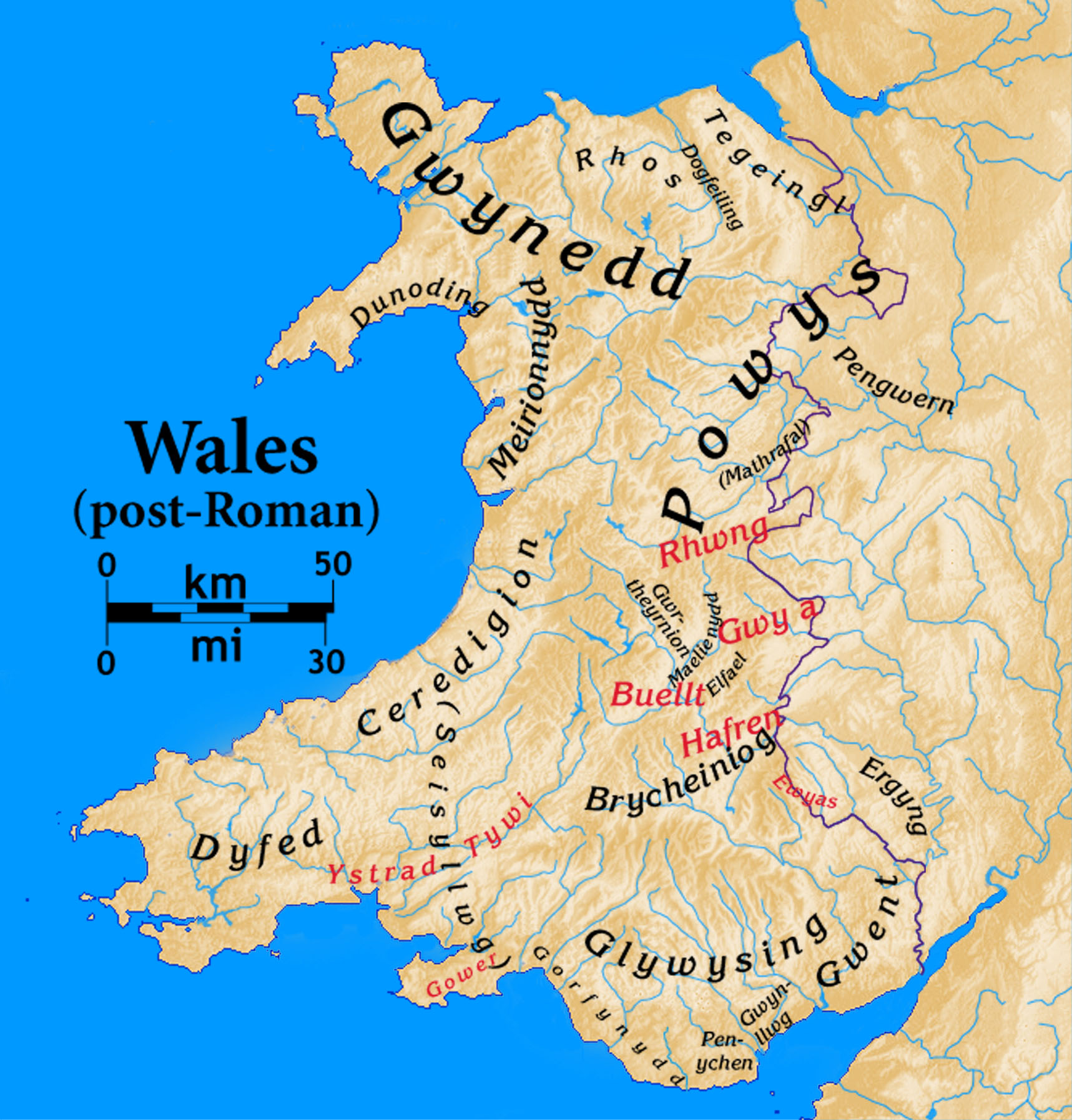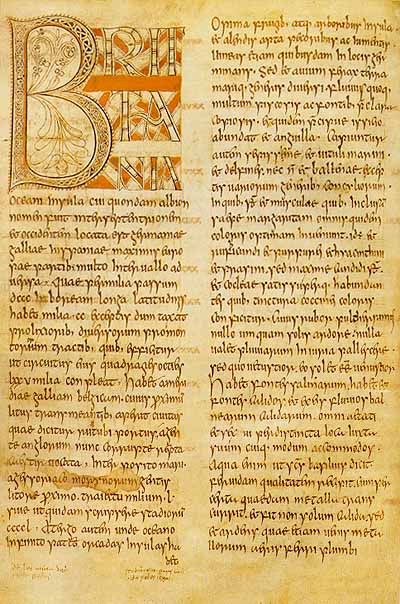|
Historia Divae Monacellae
The is the medieval Latin hagiography of Melangell (), an early medieval Welsh saint whose cult is centred at St Melangell's Church in the former village of Pennant Melangell. The chronicles the legendary life of Melangell, a consecrated virgin and hermit in the forest of Powys, and her encounter with a prince who grants her land as a sanctuary after she supernaturally protected a hare from his hunting dogs. She later established female monastics in the area. The 's authorship is subject to debate, but it was probably composed at some point in the late Middle Ages in or near Pennant Melangell, and was based on previous literature and local folklore. Several manuscripts survive, three of which are complete. The was first printed in 1848. Various interpretations of the have been put forth, such as it being written to defend Pennant Melangell's sanctuary rights in a time when Welsh churches were being threatened by local rulers. Others have analysed the as a cautionary tal ... [...More Info...] [...Related Items...] OR: [Wikipedia] [Google] [Baidu] |
Hagiography
A hagiography (; ) is a biography of a saint or an ecclesiastical leader, as well as, by extension, an adulatory and idealized biography of a preacher, priest, founder, saint, monk, nun or icon in any of the world's religions. Early Christian hagiographies might consist of a biography or ' (from Latin ''vita'', life, which begins the title of most medieval biographies), a description of the saint's deeds or miracles, an account of the saint's martyrdom (called a ), or be a combination of these. Christian hagiographies focus on the lives, and notably the miracles, ascribed to men and women canonized by the Roman Catholic church, the Eastern Orthodox Church, the Oriental Orthodox churches, and the Church of the East. Other religious traditions such as Buddhism, Hinduism, Taoism, Islam, Sikhism and Jainism also create and maintain hagiographical texts (such as the Sikh Janamsakhis) concerning saints, gurus and other individuals believed to be imbued with sacred power. However ... [...More Info...] [...Related Items...] OR: [Wikipedia] [Google] [Baidu] |
English Reformation
The English Reformation began in 16th-century England when the Church of England broke away first from the authority of the pope and bishops Oath_of_Supremacy, over the King and then from some doctrines and practices of the Catholic Church. These events were part of the wider European Reformation: various religious and political movements that affected both the practice of Christianity in Western Europe, Western and Central Europe and relations between church and state. The English Reformation began as more of a political affair than a theological dispute. In 1527 Henry VIII requested an annulment of his marriage, but Pope Clement VII refused. In response, the English Reformation Parliament, Reformation Parliament (1529–1536) passed laws abolishing papal authority in England and declared Henry to be Supreme Head of the Church of England, head of the Church of England. Final authority in doctrinal disputes now rested with the monarch. Though a religious traditionalist hims ... [...More Info...] [...Related Items...] OR: [Wikipedia] [Google] [Baidu] |
Llywelyn Ab Iorwerth
Llywelyn ab Iorwerth (, – 11 April 1240), also known as Llywelyn the Great (, ; ), was a medieval Welsh ruler. He succeeded his uncle, Dafydd ab Owain Gwynedd, as King of Gwynedd in 1195. By a combination of war and diplomacy, he dominated Wales for 45 years. During Llywelyn's childhood, Gwynedd was ruled by two of his uncles, who split the kingdom between them, following the death of Llywelyn's grandfather, Owain Gwynedd, in 1170. Llywelyn had a strong claim to be the legitimate ruler and began a campaign to win power at an early age. He was sole ruler of Gwynedd by 1200 and made a treaty with King John of England that year. Llywelyn's relations with John remained good for the next ten years. He married John's natural daughter Joan in 1205, and when John arrested Gwenwynwyn of Powys in 1208, Llywelyn took the opportunity to annex southern Powys. In 1210, relations deteriorated, and John invaded Gwynedd in 1211. Llywelyn was forced to seek terms and to give up all lands ... [...More Info...] [...Related Items...] OR: [Wikipedia] [Google] [Baidu] |
Madog Ap Maredudd
Madog ap Maredudd (, ; died 1160) was the last prince of the entire Kingdom of Powys, Wales. He held for a time, the FitzAlan Lordship of Oswestry, family of the Earl of Arundel, Earls of Arundel, of Arundel Castle. His daughter married Lord Rhys, prince of Wales. Early life Madog was the son of King Maredudd ap Bleddyn and grandson of King Bleddyn ap Cynfyn. He followed his father on the throne of Powys in 1132. He is recorded as taking part in the Battle of Lincoln (1141), Battle of Lincoln in 1141 in support of Ranulf de Gernon, 4th Earl of Chester, along with Owain Gwynedd's brother Cadwaladr ap Gruffydd and a large army of Welshmen. In 1149 he is recorded giving the commote of Cyfeiliog to his nephews Owain Cyfeiliog and Meurig. The same year Madog was able to rebuild Oswestry Castle, a fortress of William Fitzalan (rebel), William Fitzalan. It would seem likely that he had gained both the fortresses of Oswestry and Whittington Castle, Whittington in 1146 of Fitzalan, the ... [...More Info...] [...Related Items...] OR: [Wikipedia] [Google] [Baidu] |
Elise Ap Madog
Elise or Elyse may refer to: Arts and entertainment * Elise, the unidentified person to whom Beethoven dedicated ''Für Elise'' * ''Elise'', a 1979 speculative fiction novel by Ken Grimwood * ''Élise ou la vraie vie'' (''Elise, or the Real Life''), a 1967 novel by the French writer Claire Etcherelli * ''Élise ou la vraie vie'' (''Elise, or Real Life''), a 1970 French drama film based on the novel of the same name * ''Elyse'' (film), a 2020 American drama film * "Elise", an episode of the British television programme ''Foyle's War'' People and fictional characters * Élise, a list of people and fictional characters with the given name Élise, Elise, Elize, or Elyse * Elise, a character who is Marceline the Vampire Queen's mother in the TV series ''Adventure Time'' * Christine Elise (born 1965), American actress * Elise Marilyn Jones (born 1997), American actress known professionally as Chloe Cherry * Kimberly Elise, (born 1967), American actress * Lily Elise (born 1991), Americ ... [...More Info...] [...Related Items...] OR: [Wikipedia] [Google] [Baidu] |
Shrewsbury
Shrewsbury ( , ) is a market town and civil parish in Shropshire (district), Shropshire, England. It is sited on the River Severn, northwest of Wolverhampton, west of Telford, southeast of Wrexham and north of Hereford. At the 2021 United Kingdom census, 2021 census, the parish had a population of 76,782. It is the county town of the ceremonial county of Shropshire. Shrewsbury has Anglo-Saxons, Anglo-Saxon roots and institutions whose foundations, dating from that time, represent a cultural continuity possibly going back as far as the 8th century. The centre has a largely undisturbed medieval street plan and over 660 Listed buildings in Shrewsbury, listed buildings, including several examples of timber framing from the 15th and 16th centuries. Shrewsbury Castle, a red sandstone fortification, and Shrewsbury Abbey, were founded in 1074 and 1083 respectively by the Normans, Norman Earl of Shrewsbury, Roger de Montgomery. The town is the birthplace of Charles Darwin. It has ... [...More Info...] [...Related Items...] OR: [Wikipedia] [Google] [Baidu] |
Pengwern
Pengwern was a Brythonic settlement of sub-Roman Britain situated in what is now the English county of Shropshire, adjoining the modern Welsh border. It is regarded as possibly being the early seat of the kings of Powys before its establishment at Mathrafal, further west, but the theory that it was an early kingdom (or a sub-kingdom of Powys itself) has also been postulated. Its precise location is uncertain. History and legend Nothing is known about the foundation of Pengwern, although according to Welsh tradition it was part of the Welsh kingdom of Powys in the early Middle Ages. Early Powys, much larger in extent than the later medieval kingdom, seems to have roughly coincided with the territory of the Celtic Cornovii tribe, whose ''civitas'' under Roman rule (capital or administrative centre) was '' Viroconium Cornoviorum'' (now Wroxeter), replacing a fort located on the Wrekin, which was abandoned. Once the Roman legions left the area, Viroconium Cornoviorum had ta ... [...More Info...] [...Related Items...] OR: [Wikipedia] [Google] [Baidu] |
Gerald Of Wales
Gerald of Wales (; ; ; ) was a Cambro-Norman priest and historian. As a royal clerk to the king and two archbishops, he travelled widely and wrote extensively. He studied and taught in France and visited Rome several times, meeting the Pope. He was nominated for several bishoprics but turned them down in the hope of becoming Bishop of St Davids, but was unsuccessful despite considerable support. His final post was as Archdeacon of Brecon, from which he retired to academic study for the remainder of his life. Much of his writing survives. Life Early life Born at Manorbier Castle in Pembrokeshire, Wales, Gerald was of mixed Norman and Welsh descent. Gerald was the youngest son of William Fitz Odo de Barry (or Barri), the common ancestor of the De Barry family of Barry, Glamorganshire, who subsequently invaded Ireland, a retainer of Arnulf de Montgomery and Gerald de Windsor, and one of the most powerful Anglo-Norman barons in Wales. His mother was Angharad FitzGerald, ... [...More Info...] [...Related Items...] OR: [Wikipedia] [Google] [Baidu] |
Historia Ecclesiastica Gentis Anglorum
The ''Ecclesiastical History of the English People'' (), written by Bede in about AD 731, is a history of the Christian Churches in England, and of England generally; its main focus is on the growth of Christianity. It was composed in Latin, and is believed to have been completed in 731 when Bede was approximately 59 years old. It is considered one of the most important original references on Anglo-Saxon history, and according to some scholars has played a key role in the development of an English national identity. Overview The , or ''An Ecclesiastical History of the English People'', is Bede's best-known work, completed in about 731. The first of the five books begins with some geographical background and then sketches the history of England, beginning with Julius Caesar's invasion in 55 BC. A brief account of Christianity in Roman Britain, including the martyrdom of St Alban, is followed by the story of Augustine of Canterbury, Augustine's mission to England in 597, which brou ... [...More Info...] [...Related Items...] OR: [Wikipedia] [Google] [Baidu] |
Bede
Bede (; ; 672/326 May 735), also known as Saint Bede, Bede of Jarrow, the Venerable Bede, and Bede the Venerable (), was an English monk, author and scholar. He was one of the most known writers during the Early Middle Ages, and his most famous work, '' Ecclesiastical History of the English People'', gained him the title "The Father of English History". He served at the monastery of St Peter and its companion monastery of St Paul in the Kingdom of Northumbria of the Angles. Born on lands belonging to the twin monastery of Monkwearmouth–Jarrow in present-day Tyne and Wear, England, Bede was sent to Monkwearmouth at the age of seven and later joined Abbot Ceolfrith at Jarrow. Both of them survived a plague that struck in 686 and killed the majority of the population there. While Bede spent most of his life in the monastery, he travelled to several abbeys and monasteries across the British Isles, even visiting the archbishop of York and King Ceolwulf of Northumbria. ... [...More Info...] [...Related Items...] OR: [Wikipedia] [Google] [Baidu] |
Geoffrey Of Monmouth
Geoffrey of Monmouth (; ; ) was a Catholic cleric from Monmouth, Wales, and one of the major figures in the development of British historiography and the popularity of tales of King Arthur. He is best known for his chronicle '' The History of the Kings of Britain'' ( or ') which was widely popular in its day, being translated into other languages from its original Latin. It was given historical credence well into the 16th century, but is now considered historically unreliable. Life and career Geoffrey was born between about 1090 and 1100, in Wales or the Welsh Marches. He had reached the age of majority by 1129 when he is recorded as witnessing a charter. Geoffrey refers to himself in his as (Geoffrey of Monmouth), which indicates a significant connection to Monmouth, Wales, and may refer to his birthplace. His works attest to some acquaintance with the place-names of the region. Geoffrey was known to his contemporaries as or variants thereof. The "Arthur" in these vers ... [...More Info...] [...Related Items...] OR: [Wikipedia] [Google] [Baidu] |
Historia Regum Britanniae
(''The History of the Kings of Britain''), originally called (''On the Deeds of the Britons''), is a fictitious account of British history, written around 1136 by Geoffrey of Monmouth. It chronicles the lives of the List of legendary kings of Britain, kings of the Britons over the course of two thousand years, beginning with the Troy, Trojans founding the Britons (historical), British nation and continuing until the Anglo-Saxons assumed control of much of Britain around the 7th century. It is one of the central pieces of the Matter of Britain. Although taken as historical truth until the 16th century, it is now considered to have no value as history. When events described, such as Julius Caesar's Caesar's invasions of Britain, invasions of Britain, can be corroborated from contemporary histories, Geoffrey's account can be seen to be wildly inaccurate. It remains, however, a valuable piece of medieval literature, which contains the earliest known version of the story of Leir o ... [...More Info...] [...Related Items...] OR: [Wikipedia] [Google] [Baidu] |





